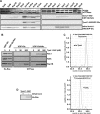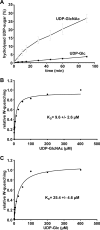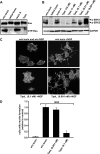Molecular characteristics of Clostridium perfringens TpeL toxin and consequences of mono-O-GlcNAcylation of Ras in living cells
- PMID: 22665487
- PMCID: PMC3408161
- DOI: 10.1074/jbc.M112.347773
Molecular characteristics of Clostridium perfringens TpeL toxin and consequences of mono-O-GlcNAcylation of Ras in living cells
Abstract
TpeL is a member of the family of clostridial glucosylating toxins produced by Clostridium perfringens type A, B, and C strains. In contrast to other members of this toxin family, it lacks a C-terminal polypeptide repeat domain, which is suggested to be involved in target cell binding. It was shown that the glucosyltransferase domain of TpeL modifies Ras in vitro by mono-O-glucosylation or mono-O-GlcNAcylation (Nagahama, M., Ohkubo, A., Oda, M., Kobayashi, K., Amimoto, K., Miyamoto, K., and Sakurai, J. (2011) Infect. Immun. 79, 905-910). Here we show that TpeL preferably utilizes UDP-N-acetylglucosamine (UDP-GlcNAc) as a sugar donor. Change of alanine 383 of TpeL to isoleucine turns the sugar donor preference from UDP-GlcNAc to UDP-glucose. In contrast to previous studies, we show that Rac is a poor substrate in vitro and in vivo and requires 1-2 magnitudes higher toxin concentrations for modification by TpeL. The toxin is autoproteolytically processed in the presence of inositol hexakisphosphate (InsP(6)) by an intrinsic cysteine protease domain, located next to the glucosyltransferase domain. A C-terminally extended TpeL full-length variant (TpeL1-1779) induces apoptosis in HeLa cells (most likely by mono-O-GlcNAcylation of Ras), and inhibits Ras signaling including Ras-Raf interaction and ERK activation. In addition, TpeL blocks Ras signaling in rat pheochromocytoma PC12 cells. TpeL is a glucosylating toxin, which modifies Ras and induces apoptosis in target cells without having a typical C-terminal polypeptide repeat domain.
Figures







Similar articles
-
Characterization of the enzymatic activity of Clostridium perfringens TpeL.Toxicon. 2013 Dec 1;75:136-43. doi: 10.1016/j.toxicon.2013.07.003. Epub 2013 Jul 12. Toxicon. 2013. PMID: 23851225
-
Clostridium perfringens TpeL glycosylates the Rac and Ras subfamily proteins.Infect Immun. 2011 Feb;79(2):905-10. doi: 10.1128/IAI.01019-10. Epub 2010 Nov 22. Infect Immun. 2011. PMID: 21098103 Free PMC article.
-
Targeting oncogenic Ras by the Clostridium perfringens toxin TpeL.Oncotarget. 2018 Mar 27;9(23):16489-16500. doi: 10.18632/oncotarget.24740. eCollection 2018 Mar 27. Oncotarget. 2018. PMID: 29662661 Free PMC article.
-
Bacterial toxin and effector glycosyltransferases.Biochim Biophys Acta. 2010 Feb;1800(2):134-43. doi: 10.1016/j.bbagen.2009.07.022. Epub 2009 Jul 30. Biochim Biophys Acta. 2010. PMID: 19647041 Review.
-
Large clostridial cytotoxins: cellular biology of Rho/Ras-glucosylating toxins.Biochim Biophys Acta. 2004 Jul 6;1673(1-2):66-74. doi: 10.1016/j.bbagen.2004.03.014. Biochim Biophys Acta. 2004. PMID: 15238250 Review.
Cited by
-
Liuwei Dihuang formula ameliorates chronic stress-induced emotional and cognitive impairments in mice by elevating hippocampal O-GlcNAc modification.Front Neurosci. 2023 Apr 20;17:1134176. doi: 10.3389/fnins.2023.1134176. eCollection 2023. Front Neurosci. 2023. PMID: 37152609 Free PMC article.
-
Comparative Genomics of Clostridium perfringens Reveals Patterns of Host-Associated Phylogenetic Clades and Virulence Factors.Front Microbiol. 2021 Jun 9;12:649953. doi: 10.3389/fmicb.2021.649953. eCollection 2021. Front Microbiol. 2021. PMID: 34177831 Free PMC article.
-
Site-specific processing of Ras and Rap1 Switch I by a MARTX toxin effector domain.Nat Commun. 2015 Jun 8;6:7396. doi: 10.1038/ncomms8396. Nat Commun. 2015. PMID: 26051945 Free PMC article.
-
Substrate Recognition of MARTX Ras/Rap1-Specific Endopeptidase.Biochemistry. 2017 May 30;56(21):2747-2757. doi: 10.1021/acs.biochem.7b00246. Epub 2017 May 11. Biochemistry. 2017. PMID: 28459538 Free PMC article.
-
Holin-Dependent Secretion of the Large Clostridial Toxin TpeL by Clostridium perfringens.J Bacteriol. 2021 Mar 23;203(8):e00580-20. doi: 10.1128/JB.00580-20. Print 2021 Mar 23. J Bacteriol. 2021. PMID: 33526612 Free PMC article.
References
-
- Borriello S. P., Aktories K. (2005) in Clostridium perfringens, Clostridium difficile, and other Clostridium species, Topley Wilson's Microbiology & Microbial Infections (Borriello S. P., Murray P. R., Funke G., eds) Hodder Arnold, London
-
- Smedley J. G., 3rd, Fisher D. J., Sayeed S., Chakrabarti G., McClane B. A. (2004) The enteric toxins of Clostridium perfringens. Rev. Physiol Biochem. Pharmacol. 152, 183–204 - PubMed
-
- Rood J. I. (1998) Virulence genes of Clostridium perfringens. Annu. Rev. Microbiol. 52, 333–360 - PubMed
Publication types
MeSH terms
Substances
LinkOut - more resources
Full Text Sources
Other Literature Sources
Molecular Biology Databases
Research Materials
Miscellaneous

